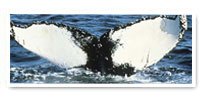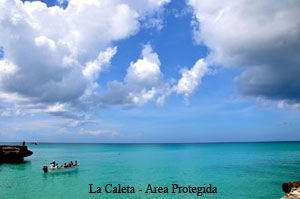|

The National Commission of Marine Mammals of the Dominican Republic
By Oswaldo E. Vásquez, M.Sc. and Atemar Eirl
Santo Domingo, 9/12/2011
INTRODUCTION
Marine mammals are a group of unique species, the vast majority in danger of extinction, that form an essential part of the Dominican Republic´s marine biodiversity. They are mainly represented by Crustaceans (Whales and Dolphins) and Sirenias (Manatees). Unfortunately, since 1959, there have been no reports on the existence of the unique Pinniped species, the Caribbean Monk Seal (Monachus tropicalis, Gray 1850), which indicates its lamentable and definitive extinction in the Greater Caribbean region.
Out of the 80 Crustacean species, in the Dominican Republic we have 18 migratory species of whales and dolphins which have, for the most part, not been extensively studied with the exception of the Humpback Whale (Megaptera novaeangliae, Borowski 1871) and two species of dolphins (Tursiops truncatus y Stenella spp) which have begun to be researched in recent decades. Regardless of these two examples, there is still little known in contrast to the research carried out on the Humpback Whale in since the middle of the 1970s.
In 1973, Dr. Howard Winn discovered the Silver Bank as a special site for Humpback Whales to reproduce. Silver Bank is an underwater platform originally of coral heads covering a surface of 3,000 square kilometers of trapezoidal-shaped reefs located some 60 nautical miles to the Northeast of the Dominican Republic, within the country’s Exclusive Economic Zone.
 This important discovery generated an avalanche of visitors to the Silver Bank with the idea of officially turning this large concentration of whales into a protected platform such as the Banco de la Plata (Silver Bank). They carried out extensive scientific research using the most diverse methodology. Experts such as Hal Whitehead, Ken Balcomb, George Nichols, Steve Katona, to name only a few for fear of leaving out someone important, dedicated years to this project. The reality is that, at the beginning of the 1980s, the Dominican Republic already knew about this unique, exclusive area where Humpback Whales came to reproduce annually between December and April. Later, research using different techniques and methodology showed that more 10,000 whales return to Silver Bank for their important reproduction process, beginning with mating then months later, also culminating in Silver Bank, the birth of their calves. It is estimated that 85% of all Humpback Whales of the North Atlantic Ocean who emigrate from temperate zones, head toward Silver and Navidad Banks. As a result, this area is of vital importance to the survival of the whale populations of the Northern Hemisphere. This important discovery generated an avalanche of visitors to the Silver Bank with the idea of officially turning this large concentration of whales into a protected platform such as the Banco de la Plata (Silver Bank). They carried out extensive scientific research using the most diverse methodology. Experts such as Hal Whitehead, Ken Balcomb, George Nichols, Steve Katona, to name only a few for fear of leaving out someone important, dedicated years to this project. The reality is that, at the beginning of the 1980s, the Dominican Republic already knew about this unique, exclusive area where Humpback Whales came to reproduce annually between December and April. Later, research using different techniques and methodology showed that more 10,000 whales return to Silver Bank for their important reproduction process, beginning with mating then months later, also culminating in Silver Bank, the birth of their calves. It is estimated that 85% of all Humpback Whales of the North Atlantic Ocean who emigrate from temperate zones, head toward Silver and Navidad Banks. As a result, this area is of vital importance to the survival of the whale populations of the Northern Hemisphere.
Years later, el Dr. Haiss began his research in Bahía de Samaná. For personal reasons, he was never able to complete his work although it led to the discovery of another important whale spawning area - La Bahía de Samaná, located in Northeastern Dominican Republic.
In synthesis, our country has three areas of extreme importance for Humpback Whale reproduction. For this reason, we need to emphasize that depending on conservationist management of these areas, we run the risk of putting the survival of this cosmopolitan species in danger. Consequently, actions taken in the DR must be intimately linked to the global conservation process of this species.
 In response to this need, Dominican technicians, headed by Professor Idelisa Bonnelly de Calventi of the Marine Biology Research Center (CIBIMA in Spanish) of the Universidad Autónoma de Santo Domingo (UASD) in addition to the efficient and opportune action taken by Francisco Geraldes, on October 14, 1986 former Dominican President Joaquin Balaguer declared Decree #319, officially establishing Silver Bank as a “Marine Mammal Sanctuary,” and renaming it “The Silver Bank Humpback Whale Sanctuary.” In response to this need, Dominican technicians, headed by Professor Idelisa Bonnelly de Calventi of the Marine Biology Research Center (CIBIMA in Spanish) of the Universidad Autónoma de Santo Domingo (UASD) in addition to the efficient and opportune action taken by Francisco Geraldes, on October 14, 1986 former Dominican President Joaquin Balaguer declared Decree #319, officially establishing Silver Bank as a “Marine Mammal Sanctuary,” and renaming it “The Silver Bank Humpback Whale Sanctuary.”
Silver Bank is an underwater platform located some 80 nautical miles northeast of Puerto Plata. It is formed by coral formations and a chain of coral heads with intricate canals that form a protective barrier from the shallow waters. Based on its unique shape, in ancient times, this area was called Thistle Bank and navigation around it was very difficult. As a result there were many shipwrecks which later caused this original name to be changed to Silver Bank.
The Silver Bank Sanctuary was the first in the world to be created with the unique conservation characteristic of hosting the densest concentration of Humpback Whales in the world. There is no other place on earth that concentrates one whale per square mile. Also, the largest number of whale births per year occurs here. In 1992, there were more than 300 whale calves born in Silver Bank.
Since the creation of the Sanctuary, permanent research projects as well as whale, dolphin and manatee conservation programs have been developed around the country. These programs, some still operating, have generated numerous scientific publications and have considerably bolstered the role of our country in the conservation of these species in the region and the hemisphere.
The Decree also created the Sanctuary Rector Commission, a multidisciplinary organization comprised of different institutions such as: the Ministry of Agriculture, the Navy, the MAMMA Foundation, MNHN, CIBIMA, Puerto Plata regional government and the National Office of Parks, among others.
In the end, this Decree started a revolution in terms of management and handling of natural resources in the country’s protected areas by ultimately creating a new category for the System of Protected Areas: Sanctuary, which, at the same time, served to consolidate other little-known categories, such as Exclusive Economic Zone. This generated the creation of a new system of co-management of a protected area and created a Rector Commission, an organization without precedent in the Dominican Republic.
We are able to say without fear of error that today we enjoy the benefits of private co-management of some protected areas as a direct result of Decree 319 which served to change the governmental position of conservation into a more pluralistic and participatory undertaking.
This time, the refrain, “all good things come to an end,” did not apply as the status quo was indeed changed with the idea of improving and that is what happened. In 1996, the limits of the Sanctuary were extended and its name was changed to “The Marine Mammal Sanctuary of the Dominican Republic” by Decree No. 233 of 1996. This included Navidad Bank and Bahía de Samana and a large part of the southeastern shoreline of Bahia. This was also included in the Category IV of the International Union for the Conservation of Nature (IUCN).
The process of creating and declaring a series of decrees in 1998-99, which we won’t stop to evaluate here, resulted in the re-establishment, through Decree 136, the limits established in Decree 233-96 and also created the National Commission for the Protection of Marine Mammals.
Once again, management criteria of protected areas is changing and becoming a Sanctuary to be managed by a group of institutions which, by their essence and origin, is multidisciplinary. The Dominican government is also participating through educational, independent and decentralized entities as well as NGOs, in the management of a special protected area like the Marine Mammal Sanctuary of the Dominican Republic.
This Commission was presided over by the National Office of Parks, the Ministry of Tourism and other private, decentralized organizations. For the first time, it began to manage a Commission which had a limited budget from monies collected from tourist visiting the whale observation areas.
This unique system of co-management of the Sanctuary ended with the creation and promulgation of Law 64-00 General Environmental and Natural Resources which is established in its Article 200, clearly and forcefully. This law, logically, renders null and void all previous decrees that were made prior to the Law.
Over the years, the Silver Bank Sanctuary was enlarged on two occasions. The first was July 5, 1998 when Bahía de Samaná was included. The second was in 2002 with the creation of Law 202 of the 2004 Regional Law of Protected Areas, when it included the Pañuelo Bank within its current limits. It was on this occasion that it acquired its current name, the Marine Mammal Sanctuary of the Dominican Republic (SMMRD in Spanish). With this extension, the area of the sanctuary grew considerably turning it into the largest protected area in the country and in the region. The surface area covers approximately 19,000 nautical square miles (some 50,000 square kilometers).
The promulgation of Law 64-00 brought about huge setbacks to the advances achieved in the area of protection of marine mammals in the country. The setbacks are such that we have gone nearly nine years trying to retrieve management and conservation instruments for marine mammals and their ocean environment.
Even though it is true that we have done a lot in the area of whale research with the most sophisticated research being done in the DR by well-trained Dominican personnel who continue to undertake permanent research and conservation programs. In terms of the institutional aspect of this issue, we are in a phase that can be compared to 1986 when the Silver Bank Sanctuary Rector Commission was created.
We make this statement with the understanding that, notwithstanding the category of the Law that sustains the protection of the marine mammals of the Dominican Republic, it is better than when protections only existed as a result of a Presidential Decree. Management of the problem in general terms in effect today leaves a lot to be desired in that we do not have an adequate management system wherein organizations, official and private entities and related participating sectors are represented.
Related Articles:
|